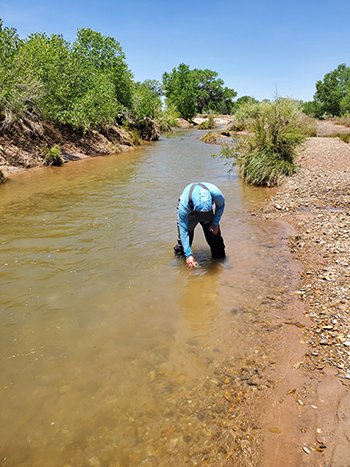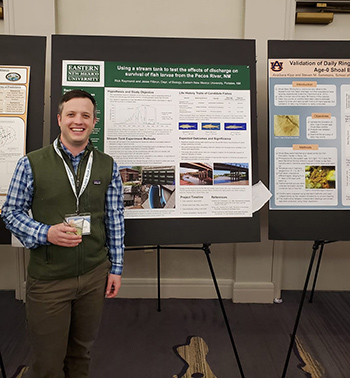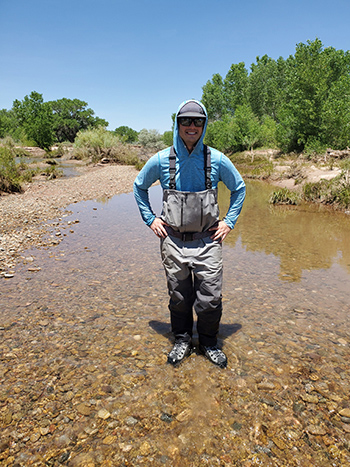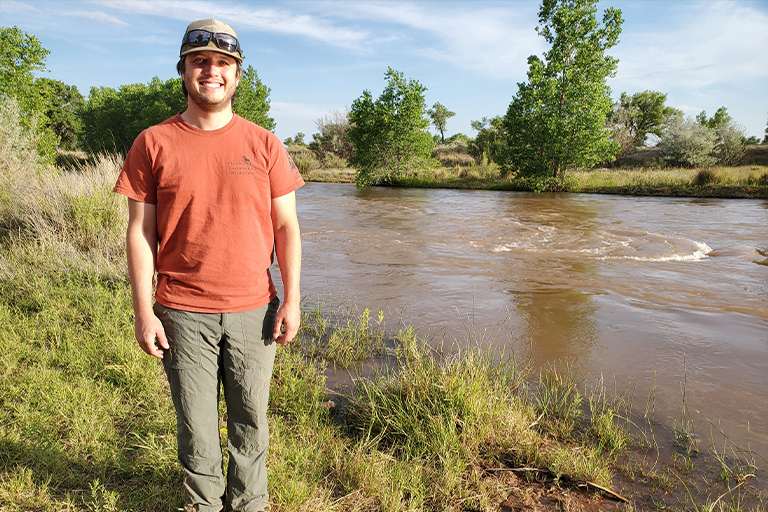Rick Raymondi, a graduate student at Eastern New Mexico University, has been awarded the New Mexico Water Resources Research Institute (WRRI) Student Water Research Grant.
He discusses his plans for the grant and what the award means to him.

What is the WRRI Student Water Research Grant? What was the selection process?
The New Mexico State Legislature has made funding available through WRRI to provide student researchers money for water-related research projects that benefit the state. To apply for this grant, I had to submit a 3-page proposal to the WRRI committee back in early May that covered a problem statement and objective, methodology, expected results and significance, and a third page dedicated to a budget. It was challenging to write a strong proposal that provided enough background information on my research objective and enough detailed information about my research methodology and significance on such few pages. Applying to this grant had no human component to the selection process, so my proposal had to be refined over and over so to convey my research efficiently and to make an impression on the selection committee.
What are your plans for the grant? Tell us about your research and how this grant will tie into that.
I will be using this reward to improve our wet lab located in the Behavioral Ecology Laboratory building by purchasing equipment that will improve our fish husbandry practices and to monitor water quality during research. My project relies on being able to artificially spawn fish in the lab as their larvae are the subject of my experiment.
I am performing a study to test the effects of high discharge released from reservoirs on pelagic-spawning minnows of the Pecos River, New Mexico. Pelagic-spawning minnows are a group of fish where the females release eggs directly in the water column to be fertilized by males. These fertilized eggs will then drift downstream, where they will hatch and continue drifting as larvae. These fishes rely on water temperature and stream flow as environmental cues to initiate spawning behavior with continuous and uninterrupted flow required to recruit to the juvenile life stage. Dam construction on the Pecos River has fragmented the river, and it no longer resembles the historical conditions in which these fishes evolved.

Plains Minnow (Hybognathus placitus) has been selected as our candidate species for the stream tank experiments due to their abundance in the Pecos River. Specimens will be captured and transported back to the Behavioral Ecology Lab at Eastern New Mexico University for spawning. With the grant, we will be able to provide aquaria that are more easily maintained, thereby increasing water quality and also provide flow as to mimic conditions in the Pecos River. Thus, we will be reducing stress to the fish with improvements made possible by the grant, which will ensure a higher rate of success when spawning fish.
How are you preparing for your upcoming presentation at WRRI's 65th Annual New Mexico Water Conference?
I presented my research proposal at the Southern Division American Fisheries Society meeting this last spring, which gave me the skills that I need to present confidently at the upcoming WRRI conference. That being said, all I can do now to prepare is by performing my research and obtain data so I can present results at the WRRI conference.
What does it mean to you to receive this grant?
This was a huge achievement and one that I am very proud to have accomplished as that I never expected to be rewarded a grant while in graduate school. The whole process of writing the grant has given me invaluable experience that I can now use to market my abilities when I pursue a career after I graduate ENMU.
What do you hope to pursue as a career? How do this grant and your time at ENMU tie into your career goals?
My ultimate goal has always been to work with anadromous fish in the Northwest United States, but to what end has been the unknown factor. Just because my research project involves desert fishes and not salmonids, I am learning the techniques every professional needs when pursuing a career in the sciences. Becoming familiar with the grant writing process and the technical writing aspect that is involved has been possible through the courses I have taken and the advisement I have received due to my time at ENMU.

What is your major? Why did you choose that field of study?
Biology. I gravitated towards the field of biology mainly because of ecology: the relationship between organisms and their environment. Growing up in the Northwest United States, my interest in ecology grew as I was observing first hand the rapid decline of anadromous fish, specifically Chinook Salmon and Steelhead Trout, due to the construction of dams and other diversion projects in their habitat. The desire to understand the interactions of fishes and their environment has steered me into the field of biology and is ultimately why I am where I am today.
Which professors have helped mentor you during your time at ENMU?
Dr. Jesse Filbrun is not only my graduate advisor but has also been mentoring me through my time at ENMU. Being rewarded this grant would not have been possible without guidance and expertise in fisheries.
What advice would you give to students who are interested in your field of study and research?
Biology is an ever-changing discipline, so being able to keep an open mind is not only crucial but is respectable.



